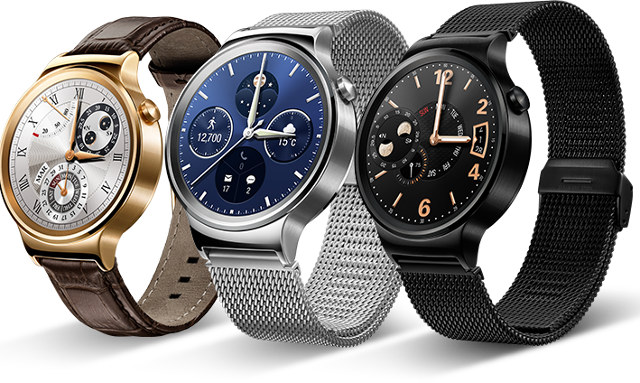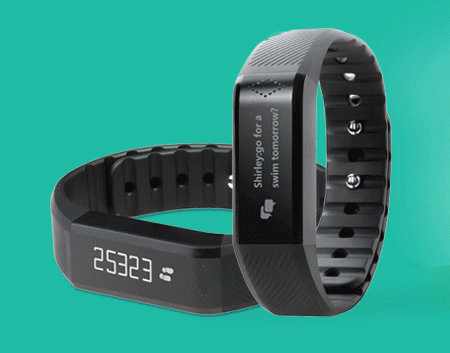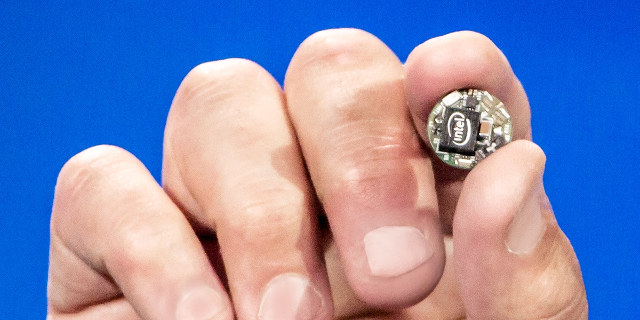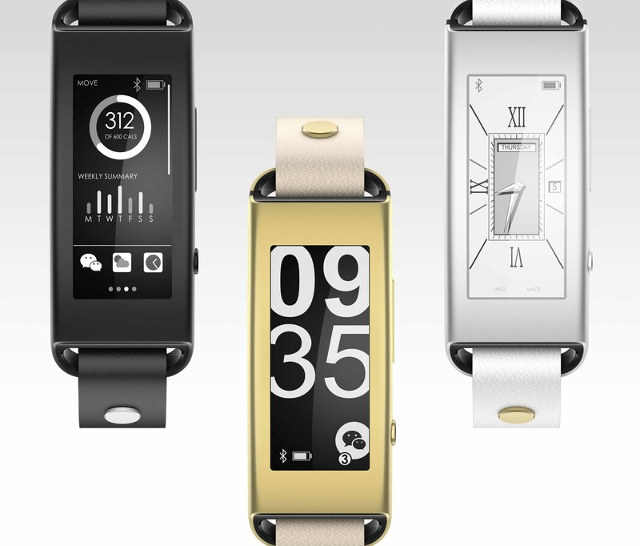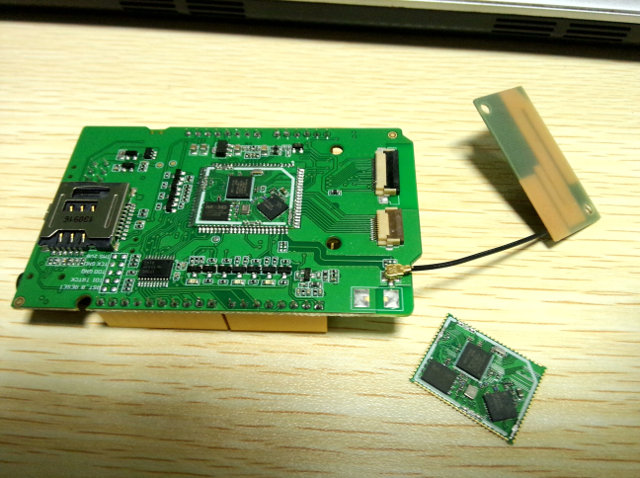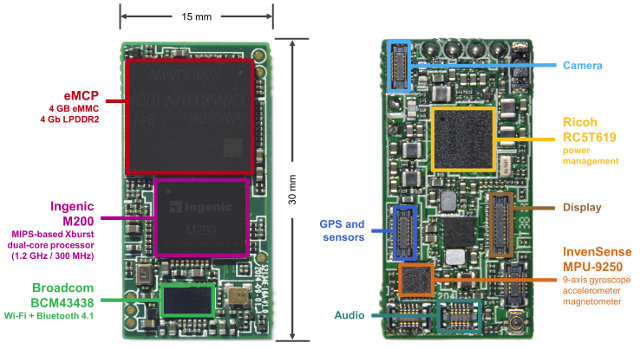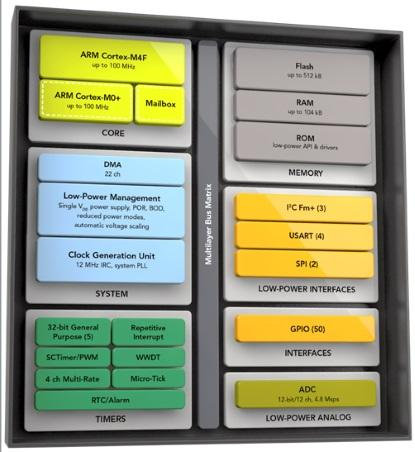If you think Motorola Moto 360 looks good, but find the black zone at the bottom of the display ruins it all, Huawei Watch may be what you’ve been looking for, with a similar rounded shape design, Android Wear, and when it is in watch mode it really looks like a standard watch without obstructions. Let’s go through the specifications first: SoC – Qualcomm Snapdragon 400 (APQ8026) quad core Cortex A7 @ 1.2GHz with Adreno 305 GPU System Memory – 512MB RAM Storage – 4GB ROM Display – 1.4″ full circle AMOLED display; 400×400, 286ppi; Sapphire crystal Audio – Built-in MIC Connectivity – Bluetooth 4.0/4.1 Sensors – Gyroscope + Accelerometer, PPG (photoplethysmogram – for heart rate), Barometer, Vibration Motor Misc – Watch button at 2 o’clock Battery – 300mAh Material – Watch: 316L Stainless Steel; Watchband: stainless steel or leather Dimension – 42mm diameter by 11.3mm thickness Weight – […]
Vidonn X6 Activity Tracker Promises Up to 15 days Battery Life
I reviewed Vidonn X5 fitness tracker last yet, and I found many issues or letdowns: battery life is too short (2 days), the digits are much smaller than advertized, the screen cannot be read under direct sunlight, a button must be pressed to check the time, the smartband is not as waterproof as advertized, and the Android app is a disaster. Despite all these issues, I still wear it everyday, as it helps me walk or run a bit more if I have not reached my daily target. The company has now release a new model Vidoon X6 that I discovered today on DealExtreme for $33.90. Vidonn X6 specifications: MCU/Memory – Unknown Display – 0.88″ OLED display (vs 0.49″ for X5) Connectivity – Bluetooth 4.0 LE and micro USB Battery – 45 mAh Li-battery (vs 40 mAh) good for 15 days in standby mode. IP Rating – IP65 (Dust-proof and […]
Intel Curie Board Designed for Wearables is Powered by Quark SE SoC
Intel announced the Edison board at CES 2014, a board targetting wearables and IoT applications about the size of an SD card. At CES 2015, the company has gone smaller, by unveiling the button-sized Intel Curie module powered by a new Intel Quark SE SoC with a motion sensor, Bluetooth Low Energy connectivity and battery charging capabilities. Intel Curie specifications: Low-power, 32-bit Intel Quark SE SoC 384kB Flash memory, 80kB SRAM Low-power integrated DSP sensor hub with a proprietary pattern matching accelerator Bluetooth Low Energy 6-axis combo sensor with accelerometer and gyroscope Battery charging circuitry (PMIC) The module runs an unnamed open source RTOS, and the company will provide IQ software kits for references applications for wearables, such as counting steps, apps for mobile device, and so on. Intel Curie is expected to be found in smart products such as rings, bags, bracelets, pendants, fitness trackers and buttons. There’s basically no […]
$89 Lenovo VIBE Band VB10 Activity Tracker Features an E-Ink Display, 7-Day Battery Life
Last year, when I bought a cheap fitness band with an OLED display, I thought even if I don’t end up using the fitness features, I could also use it as a watch. I was wrong, or at least partially wrong, as although it displays the time, you need to press a button to make it show up, the display is unreadable under the sun, and you need to charge the thing every two days. Lenovo VIVE Band VB10 fitness band, announced at CES 2015, promises to greatly improve on all these issues thanks to an always on E-Ink display, which also helps it achieve 7-day battery life. This device is all the more interesting as it will only cost $89, and looks really good. The full technical details are not available yet, but we do know the display will support up to 150 characters, good enough to display SMS, […]
LinkIt A-Core Packs Mediatek MT2502A SoC into a Tiny Module for Wearables
LinkIt ONE is a development board based on Meditak MT2502A SoC for wearables, and developed by SeeedStudio. With GPS, Wi-Fi, and GSM/GPRS connectivity, and a LiPo battery, it’s great to experiment IoT or wearable applications, but if you plan to launch an actual product, it could be nice to have a module, and built a baseboard around it. That’s exactly what SeeedStudio is working with LinkIt A-Core module. LinkIT A-Core module specifications: SoC – Mediatek MT2502AV ARM7 SoC @ 260 MHz with 32MB PSRAM and 32MB Flash on-chip. External Storage – 16M external Flash (MX25U12835F) Cellular Connectivity – GSM/GPRS quad-band 850/900/1800/1900MHz with RF7198 RF transmitter. Connectivity – Bluetooth 2.0 / 2.0 EDR / 4.0, GPS compatible GPS/GNSS (requires external GPS module) Expansion – 48 general purpose digital I/O Power supply: DC 3V~4.2V Power Consumption – > 3mA Dimensions – 19x23x2 mm The module is still in development, and the company welcomes […]
Crowdfunding Report for 2014 on CNX Software Blog
Following up on my 2013 Crowdfunding Report, I’ve gone through all 55 Kickstarter and Indiegogo crowdunding projects featured on CNX Software between December 2013 and November 2014 (inclusive) to see how well they fared. The table below sort projects chronologically as they were published on this very blog. Date Project Crowdfunding Site Funded? Pledged amount / Goal Expected Delivery Actual Delivery Comments 2. Dec. 2013 Micro Python Kickstarter Yes 97,803 GBP / 15,000 GBP 03/2014 04/2014 Available @ https://micropython.org/store/#/store 5. Dec. 2013 Plugaway Kickstarter Yes $162,835 AUD / $50,000 AUD 04/2014 – People upset because of lack of updates. Project might be dead, and backers lost their money 6. Dec. 2013 AIRTAME Indiegogo Yes $1,268,332 / $160,000 05/2014 12/2014 People have started received the beta versions, after a massive 8-month delay 7. Dec. 2013 Crystal Board Kickstarter No $14,574 / $200,000 04/2014 – The project appears to be dead 10. […]
Ingenic Unveils Newton2 Platform for Wearables with M200 Dual Core SoC
Ingenic Newton is a development platform for wearables powered by Ingenic JZ4775, an application processor mostly used in tablets. Many companies are now making SoCs speficially designed for wearables with a powerful application core, and a low power core serving as a sensor hub, an Ingenic M200 SoC found in the new Ingenic Newton2 platform, uses the sample principle by combinging a MIPS XBurst processor @ 1.2GHz with a low power MIPS XBurst core @ 300MHz combined with low power GPU and VPU. Ingenic Newton2 specifications: SoC – Ingenic M200 dual core processor with MIPS XBurst @ 1.2 GHz, MIPS XBurst @ 300 MHz, 2D/3D GPU, and VPU supporting H.264, VP8, MPEG-1/2/4, VC-1, and RV9 up to 720p30 System Memory – 512 MB LPPDR2 (Samsung eMCP) Storage – 4GB eMMC (Samsung eMCP) Connectivity – 802.11 b/g/n Wi-Fi + Bluetooth 4.1 (Broadcom BCM43438) + connector for GPS Sensors – Gyroscope, accelerometer, magnetometer […]
NXP Introduces LPC54100 Single & Dual Core Cortex M4F/M0+ MCU Family and LPCXpresso54102 Development Kit
NXP has recently introduced LPC54100 Series microcontrollers with a Cortex-M4F core up to 100MHz, and optionally an ARM Cortex M0+ core for always-on sensor processing applications, as well as LPCXpresso 54102 board. Typical applications include mobile, portable health and fitness, home and building automation, fleet management and asset tracking, robotics and gaming. Key features of LPC54100 series MCUs: CPU – 32-bit ARM Cortex-M4F up to 100 MHz, optional 32-bit ARM Cortex-M0+ coprocessor On-chip RAM – 104 KB internal RAM On-chip Storage – Up to 512 KB on-chip Flash Interfaces 3 fast-mode plus I²C, 4 UART, 2 SPI, 39 GPIO ADC with up to 12-channels, 12 bits, and 4.8 Msps sample rate, full-spec (1.62 V to 3.6 V) Clock Sources – IRC, digital clock input, PLL, 32 kHz XTAL, WWDT Timers – 5x 32-bit general-purpose timers/counters, One-state configurable timer/PWM, RTC with alarm, and WWDT 22-channel DMA with 20-programmable triggers Power consumption […]


